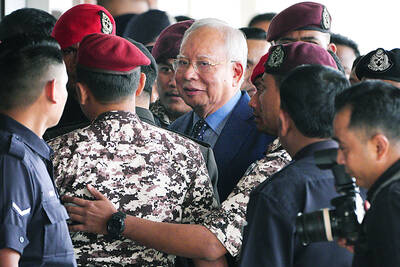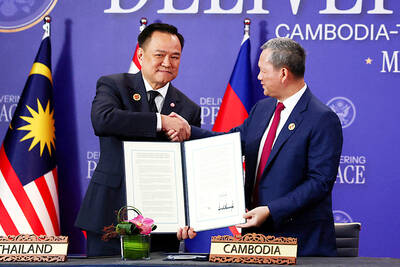Expanding an old weapon in the struggle against infectious disease, the US Centers for Disease Control and Prevention (CDC) has opened 10 new quarantine stations at major ports of entry in the past 18 months and plans to add several more in the coming year.
The US now has medical officers at 17 airports and at the busy border crossing in El Paso, Texas, to screen people entering the country for communicable diseases. They are particularly alert for travelers showing symptoms of the avian influenza virus that has spread across Asia and into Europe.
The avian flu strain, known as H5N1, has forced the slaughter of millions of chickens and other fowl and has caused 67 human deaths as of late last week, according to the World Health Organization. The virus, while affecting huge numbers of birds, is not yet efficiently transmitted among people. But medical authorities fear that the virus could mutate into a lethal human flu strain and touch off a global pandemic that could kill millions.
William MacKenzie, the medical officer at the CDC quarantine station at Los Angeles International Airport, said things were quiet in his small office. He receives one or two reports a week from international airlines reporting passengers with flu-like symptoms. Those travelers are examined and asked about where they had traveled and whether they had contact with live birds.
No such cases have arisen, MacKenzie said, but if one did, the passenger would not be detained but referred to a local hospital. Because there are few cases of human-to-human infection, the remaining passengers on the aircraft would not be quarantined, he said.
MacKenzie said flight crews have been told to closely monitor passengers for obvious signs of flu -- fever, sneezing, coughs -- and carry masks for sick passengers to limit the spread of airborne germs. In rare cases, he said, airlines are asked to isolate ill passengers and then escort them to quarantine officers at the airport.
But because so few people have become sick from the new avian virus, there is no aggressive surveillance of inbound air passengers, he said.
"At this point, we're not actively looking for sniffles and coughs," MacKenzie said. "Of course, that could change if there was a change in the transmission pattern and human-to-human infection becomes common."
The US' quarantine program essentially died in the 1970s with the eradication of smallpox and several other communicable diseases. But the perceived need for greater medical surveillance at US borders has gained new attention since 2001, when the anthrax attacks brought a new fear of biological terrorism.

Shamans in Peru on Monday gathered for an annual New Year’s ritual where they made predictions for the year to come, including illness for US President Donald Trump and the downfall of Venezuelan President Nicolas Maduro. “The United States should prepare itself because Donald Trump will fall seriously ill,” Juan de Dios Garcia proclaimed as he gathered with other shamans on a beach in southern Lima, dressed in traditional Andean ponchos and headdresses, and sprinkling flowers on the sand. The shamans carried large posters of world leaders, over which they crossed swords and burned incense, some of which they stomped on. In this

‘NO COUNTRY BUMPKIN’: The judge rejected arguments that former prime minister Najib Razak was an unwitting victim, saying Najib took steps to protect his position Imprisoned former Malaysian prime minister Najib Razak was yesterday convicted, following a corruption trial tied to multibillion-dollar looting of the 1Malaysia Development Berhad (1MDB) state investment fund. The nation’s high court found Najib, 72, guilty on four counts of abuse of power and 21 charges of money laundering related to more than US$700 million channeled into his personal bank accounts from the 1MDB fund. Najib denied any wrongdoing, and maintained the funds were a political donation from Saudi Arabia and that he had been misled by rogue financiers led by businessman Low Taek Jho. Low, thought to be the scandal’s mastermind, remains

Near the entrance to the Panama Canal, a monument to China’s contributions to the interoceanic waterway was torn down on Saturday night by order of local authorities. The move comes as US President Donald Trump has made threats in the past few months to retake control of the canal, claiming Beijing has too much influence in its operations. In a surprising move that has been criticized by leaders in Panama and China, the mayor’s office of the locality of Arraijan ordered the demolition of the monument built in 2004 to symbolize friendship between the countries. The mayor’s office said in

FIGHTING CONTINUES: Thai military dropped 40 bombs on border areas, Cambodia said, while Bangkok said Phnom Penh launched heavy attacks and damaged homes Cambodia yesterday accused Thailand of intensifying its bombardment of disputed border areas, even as officials from the two countries attend a multi-day meeting aimed at negotiating an end to deadly clashes. The neighbors’ long-standing border conflict reignited this month, shattering an earlier truce and killing more than 40 people, according to official counts. About 1 million people have also been displaced. Cambodian and Thai officials were in their third day of talks at a border checkpoint, with ministers of defense from the two countries scheduled to meet today. However, the Cambodian Ministry of National Defense said Thailand’s military carried out a heavy